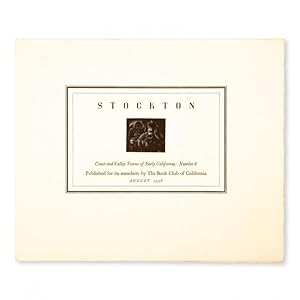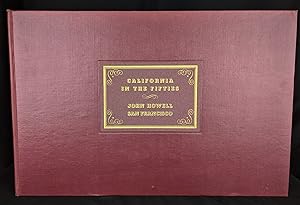Kuchel & Dresel (6 results)
Product Type
- All Product Types
- Books (6)
- Magazines & Periodicals
- Comics
- Sheet Music
- Art, Prints & Posters
- Photographs
- Maps
-
Manuscripts &
Paper Collectibles
Condition
- All Conditions
- New
- Used
Binding
- All Bindings
- Hardcover (1)
- Softcover
Collectible Attributes
- First Edition
- Signed
- Dust Jacket (2)
- Seller-Supplied Images (2)
- Not Printed On Demand
Free Shipping
Seller Location
Seller Rating
-
Coast and valley towns of early California : Number 8 : Stockton
Seller: Douglas Stewart Fine Books, Armadale, VIC, Australia
San Francisco : Book Club of California, 1938. Octavo, publisher's light brown illustrated folded paper sheet (light pencil note to back sheet), 4 pp, with colour lithograph; internally very clean, a very good copy. One of 700 copies. "Coast and Valley Towns of Early California is a series of twelve lithographs one of which will be distributed each month during 1938 to members of The Book Club of California. Each unit of the series will be designed by a different printer and will be limited to 700 copies. [.] The view of Stockton is from an original lithograph made by Kuchel & Dresel, San Francisco, in 1855" - Colophon. The Windsor Press was established in San Francisco in 1926 by the Australian brothers, James and Cecil Johnson, with James as the typographer/artist, and Cecil as the manager.The brothers ceased operation of the Windsor Press in 1942.
-
California in the Fifties
Published by John Howell, 1936
Seller: B Street Books, ABAA and ILAB, San Mateo, CA, U.S.A.
Hardcover. Condition: Very Good. Dust Jacket Condition: Very Good. Kuchel & Dresel and others (illustrator). Beautiful collection of cities and mining towns in California and the west, from early San Franciscan lithographers. Limited printing, one of 1000 copies. Light brown dust jacket has small tears all along the edges, with some additional rubbing in the corners. Hardcover is slightly faded, with some light spotting. There are a couple of stains on the back cover. Edges are slightly bumped, and there a damp stain on the bottom left edge of text block, close to the spine. Stain does not continue onto interior of the page. Otherwise, pages are clean and unmarked.
-
Views of the New Ditch, of the Columbia & Stanislaus River Water Co.
Published by F. Holtzmann, Columbia, Tuolumne Co., California
Seller: Arader Galleries of Philadelphia, PA, Philadelphia, PA, U.S.A.
Book
N/A. Condition: Very Good. Dust Jacket Condition: N/A. Tinted lithographic sheet (ca. 1855) containing six separate views: Part of the Flume Near Donnell's Flat.; Entrance of the Tunnel, 3,162 Feet Long.; Donnell & Parsons Sawmill.; Dome Rock.; The High Flume, 200 Feet High From Low Water Mark to Top.; The Fall, 50 Feet HIgh. Drawn from nature by F. Holtzmann. L. Nagel, Print. Kuchel & Dresel's Lith. 176 Clay St., S.F. Sheet size: 23 x 26 1/8". Inventory#: p636pmat. 0.
-
Shasta, Shasta County, Cal.
Published by [San Francisco]: A. Roman & Brother. 1856., 1856
Seller: Arader Galleries - AraderNYC, New York, NY, U.S.A.
Single sheet (13 2/8 x 18 6/8 inches). A FINE lithographed view of Shasta, with original hand-colour in full. This fine view of Shasta in California is from "Kuchel & Dresel's California Views" which included "all the important cities and mining towns, with a few of Oregon and Washington, issued during 1855, 1856, 1857, and 1858. They were sometimes published by a local merchant, often the bookseller [as here]. Many of them were framed by a border of views of important buildings, ranches, and mines in and about the town portrayed." (Peters page 142). Kuchel was born in Zweibrucken in 1820, and when he arrived in America work initially for P.S. Duval in Philadelphia. He began collaborating with Dresel in 1853. Kuchel and Dresel capture this bird's-eye view of Shasta, in Shasta County, California only a few years after it was created as one of the original counties of California in 1850. In 1852 parts of the county's territory were given to Siskiyou County, and later to Tehama County in 1856. Named after Mount Shasta which in turn is from the English equivalent for the name of an Indian tribe that once lived in the area. Peters, "California on Stone", pages 143 and 145; see Streeter 2787. Catalogued by Kate Hunter.
-
Yreka, Siskiyou County, California. 1857
Published by [San Francisco]: A. Roman & Brother. 1856., 1856
Seller: Arader Galleries - AraderNYC, New York, NY, U.S.A.
Single sheet (18 2/8 x 24 inches, full margins, showing the plate-mark). A FINE lithographed view of Yreka with original hand-colour in full and heightened with gum arabic. This iconic view of the gold-mining town of Yreka in California is from "Kuchel & Dresel's California Views" which included "all the important cities and mining towns, with a few of Oregon and Washington, issued during 1855, 1856, 1857, and 1858. They were sometimes published by a local merchant, often the bookseller [as here]. Many of them were framed by a border of views of important buildings, ranches, and mines in and about the town portrayed." (Peters page 142). Kuchel was born in Zweibrucken in 1820, and when he arrived in America work initially for P.S. Duval in Philadelphia. He began collaborating with Dresel in 1853. Kuchel and Dresel capture a birds-eye view of this bustling Gold Rush town just a few years after the first discovery of gold and its founding. As such it is a remarkable and important historical record of the times. Initially named "Thompson's Dry Diggings" "Gold was discovered here in March 1851 by Abraham Thompson, member of a party which was enroute from Oregon to Scott Bar. Following a heavy rainstorm, particles of gold in the roots of grass pulled up by pack animals caused Thompson to wash three pans of gravel. The results convinced the party that the area was rich enough to work. In the party were Dr. F. G. Hearn, Judge Silas J. Day and a Mr. Bell, Thompson's partner. All staked claims on these flats thirty feet square, and it was named "Thompson's Dry Diggings". Within six weeks 2,000 prospectors rushed here to mine, but the need of water caused the settlement to move to the creek. And it became known as Shasta Butte City. This name being confused with Shasta, in Shasta County. Was changed to "I-E-K-A," The Indian word for Mt. Shasta. "Now Yreka" in 1852" (Plaque at site of Thompson's discovery of gold). Peters, "California on Stone", pages 143 and 146; see Streeter 2787. Catalogued by Kate Hunter.
-
Weaverville, 1856. Trinity County, California
Published by [San Francisco: ?Fagg & Feast, 1856]., 1856
Seller: Arader Galleries - AraderNYC, New York, NY, U.S.A.
Single sheet (17 4/8 x 25 inches, full margins, showing the plate-mark). A FINE lithographed view of Weaverville (a bit browned). This fine view of Weaverville in California is from "Kuchel & Dresel's California Views" which included "all the important cities and mining towns, with a few of Oregon and Washington, issued during 1855, 1856, 1857, and 1858. They were sometimes published by a local merchant, often the bookseller [as here]. Many of them were framed by a border of views of important buildings, ranches, and mines in and about the town portrayed." (Peters page 142). Kuchel was born in Zweibrucken in 1820, and when he arrived in America work initially for P.S. Duval in Philadelphia. He began collaborating with Dresel in 1853. Kuchel and Dresel capture this early large-scale bird's-eye view of the Gold Rush town of Weaverville, and it is the earliest recorded in Reps, "Views and Viewmakers of Urban America" (443). Weaverville was only founded in 1850 during the Gold Rush, and attracted a large proportion of Chinese miners. "Weaverville owes its origin to the rush into northwestern California, which the discoveries of Pearson B. Reading started. By the summer of 1851 it was a thriving mining center, inhabited largely by Missourians, and had a reputation of being the roughest camp in California. And for years afterwards this reputation held. William H. Brewer was in Weaverville in September, 1862. He.comments on the high cost of freights, and says further: 'Sluices run through the town. There are multitudes of Chinese. There are twenty-eight saloons and liquor holes in the place and fighting and gambling are favorite pastimes.' Today Weaverville, Trinity's county seat since its organization, is a quiet and prosperous town with extensive interests in gold mining" Watson "California in the Fifties" (40). Peters, "California on Stone", pages 143 and 146; see Streeter 2787. Catalogued by Kate Hunter.




